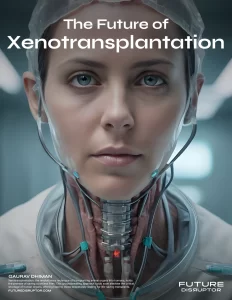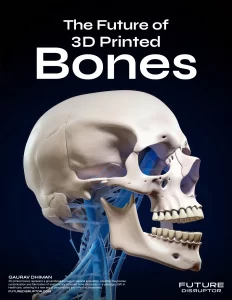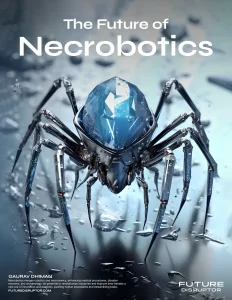30+ Solutions to Reverse Climate Change

While we currently face challenges in managing and reversing climate change, we look to the future with hope, optimism, and a deep commitment. The answer to completely reversing climate change lies in progressive technological advancements, immense international cooperation, and the unwavering dedication of individuals and organizations worldwide.
An important aspect of Future Disruptor is to speculate by combining the power of imagination, futures thinking principles, and what we know today – past, present, and expected future possibilities. This list focuses on open-ended solutions to explore the advancements that can help us reverse climate change.
Bioengineering Seaweeds: Advancements in bioengineering can enable the growth of seaweeds that capture and store carbon much faster than terrestrial forests. These could be grown in large offshore farms, capturing carbon dioxide from the atmosphere and ocean surface. Once these engineered seaweeds die, they sink into the deep ocean, sequestering carbon away from the atmosphere for centuries to millennia.
Carbon-Negative Concrete Production: Concrete production is one of the significant contributors to global carbon dioxide emissions. We can develop innovative technologies that capture the carbon dioxide emitted during production and use it as a raw material for production. This will make concrete production carbon-negative, removing more carbon from the atmosphere than it adds.
Climate Geoengineering: This term is used for large-scale interventions that can potentially cool the Earth’s climate system. Techniques like Cirrus Cloud Thinning (CCT) can be explored further with safe environmental practices. Cirrus clouds trap heat, and thinning them out may allow more longwave radiation to escape from Earth into space, thereby cooling the planet.
Energy-Generating Trash Converters: Advancements in energy technology could pave the way for trash converters that convert non-biodegradable waste into usable energy while simultaneously capturing and storing harmful greenhouse gases commonly released during waste disposal.
The Halo System: This system uses circular shields in space that redirect sunlight away from the Earth. Positioned strategically at the Lagrange point (a point in space where the gravitational forces of the earth and sun balance the centrifugal force felt by an object), this system could slow down global warming by letting less sunlight reach our planet.
Climate Correction Satellites: Launch Climate Correction Satellites (CCS) into space that could have the ability to reflect some portion of sunlight into outer space, effectively realizing the concept of solar radiation management on a global scale.
Nude Food Movement: Advances in biotechnology could develop edible packaging, thereby eliminating packaging waste. This minimizes landfill usage and works as a carbon sequester if mass-produced, as they could absorb carbon dioxide during their growth phase.
Artificial Photosynthesis: Scientists and engineers could create artificial plants or use specific bacteria and prototypes for artificial photosynthesis. These would mimic the natural process of photosynthesis to absorb and convert carbon dioxide into oxygen and carbohydrates at an accelerated rate.
Iron Fertilization: This experimental technique draws on adding iron to oceans to promote phytoplankton growth, which would absorb carbon dioxide from the atmosphere through photosynthesis.
Sky Mining: This involves deploying specialized drones that can capture carbon and remove it from the atmosphere, effectively helping to reduce the concentration of CO2.
Enhanced Weathering: Enhancing the natural weathering process can be a positive step toward mitigating climate change. When rocks weather or break down, the process naturally absorbs CO2 from the atmosphere. Technological advancements could speed up or amplify this process, sequestering more carbon and helping restore a balanced carbon cycle.
Chemical Carbon Capture: Developing advanced chemical processes that selectively extract CO2 from the air is another possible way forward. These captured chemicals can then be stored or transformed into other beneficial substances.
Bioenergy with Carbon Capture and Storage (BECCS): This system produces bioenergy by combusting biomasses like wood pellets and crops while capturing and storing evoked carbon emissions.
Python Energy System: This innovative and novel technology is aimed at the thermal decomposition of waste material and its conversion to Pyrolysis Oil, a type of synthetic fuel, thus combating climate change effectively.
Plant Biomimicry: Just as artificial photosynthesis mimics plants to capture carbon, specific architectural and industrial designs can incorporate more significant plant biomimicry principles. Buildings and infrastructure can mimic plants’ behaviors and characteristics, combining with living green material to absorb and sequester CO2.
Advanced Nuclear Power: Future nuclear technology, like fusion power, could provide extensive, consistent energy with practically no greenhouse gas emissions. This path faces significant technical hurdles, but if successful, it could provide a substantial part of our power needs.
Carbon Mineralization: This process mimics and accelerates natural weathering processes where carbon absorbed by rainwater gets converted into bicarbonate ions, making it non-gaseous and hence posing no harm to climate.
Carbon Farming: Using advanced agricultural techniques, such as agroforestry, cover cropping, and rotational grazing, we can drastically improve the ability of farms to absorb and store carbon from the air. These techniques can be powered with AI and IoT technologies for precise control and monitoring.
Artificial Glaciers: A technique devised by scientists is the creation of artificial glaciers. Engineers could create eloquent systems that store and freeze the excess water flow in the winter, creating “artificial glaciers” that melt in the spring, providing water for crops during the critical growing season.
Blue Carbon Projects: These focus on restoring, protecting, and developing coastal ecosystems like mangroves, seagrasses, and salt marshes due to their much higher carbon sequestration ability than terrestrial ecosystems. Bioengineering techniques, drones, and IoT can be used to develop and monitor these Blue Carbon Projects effectively.
Air Capture Technology: Besides commonly used carbon capture techniques, advanced materials science could develop powerful absorbents or machines capable of capturing CO2 directly from the atmosphere.
Carbon Batteries: Partnering with advancements in nanotechnology, carbon batteries or ‘green batteries’ could offer an alternative energy storage system. While still largely theoretical, this invention can revolutionize our power grid, making renewable energy sources more reliable and widespread.
Planetary Albedo Engineering: This involves increasing Earth’s reflectivity by changing natural reflectors like ice sheets, grasslands, and forests or creating artificial ones. This can be achieved by planting genetically modified trees with higher reflectivity or covering deserts with reflective material.
Nanotechnology in Solar Panels: Use nanotechnology to increase the efficiency of solar panels, allowing them to convert more sunlight into electricity. This helps in harnessing more renewable energy sources, reducing the reliance on fossil fuels.
Carbon-Sniffing Trees: Advances in biotechnology can potentially create genetically modified trees that could sequester a significantly more significant amount of carbon dioxide compared to regular trees.
Wave and Tidal Energy Harnessing: Waves and tides are an inexhaustible resource provided by nature, and if appropriately harnessed by using technological advancements like wave energy converters or tidal barrages, they may provide a significant portion of the world’s electricity need, thereby reducing emissions.
Space-Based Solar Power (SBSP): The idea is to place huge solar arrays in space, where sunlight is constant and unhindered by atmospheric conditions, and to transmit the gathered energy back to Earth. This technology is projected to yield vast amounts of renewable energy, reducing our dependence on fossil fuels.
Smart Grid Technology: Develop AI-powered smart grid technology to manage electricity usage efficiently, thereby reducing overall energy usage and carbon emissions. With smart grid technology, microgrids could be created to manage power from renewable sources and store it more effectively.
Geo-Tagging and Monitoring Nature’s CO2 Sinks: Using existing satellite monitoring technologies, scientists can geo-tag natural carbon sinks like forests and monitor the carbon sequestration process in real time.
Methane Farming: Invest in sustainable methods of harnessing methane gas produced by livestock. This would involve capturing the gas directly from animals or their waste and utilizing it as biofuel.
Smart Fabrics: The fashion industry greatly contributes to climate change. Innovations in material technology like smart, sustainable fabrics could help to remedy this. Nanotechnology, for instance, could be used to develop efficient and reusable materials that can self-clean, thereby reducing water and energy consumption in laundry.
Algae Biofuel Technology: Given the high oil content of algae (close to 50%) and its fast growth, developing technology that can efficiently turn algal biomass into biofuel would help to reduce greenhouse gas emissions.
Hydrogen Fuels: If we develop an efficient and sustainable method to produce more hydrogen fuel, we could potentially power cars, homes, and commercial buildings. Hydrogen fuel cells emit only warm air and water vapor, making them a clean, reliable, high-performance alternative energy source.
Permafrost Emission Control: Adopt technologies that prevent the melting of permafrost. As permafrost melts due to climate change, it releases large amounts of methane, a potent greenhouse gas.
Quantum Computing: Using quantum computers to process complex climate modeling simulations rapidly, further improving our understanding of the climate crisis and identifying the most effective solutions.
Pulverized Oyster Shell Lime: Ground-up oyster shells can also be used in farming and landscaping to trap carbon and counter acidity in soils, fostering plant growth and enabling more efficient carbon sequestration.
In this brightest of futures, reversing climate change is a reality not just because of technological advancements but because we have changed how we live and work, how we grow our food, and how we treat the Earth. It will require a shift of consciousness and a continual commitment to the health of our planet, but the reward – a thriving, sustainable Earth – is priceless and a legacy worth leaving for generations to come. Please share your speculative strategies and ideas to reverse climate change.

Learner-in-Chief at Future Disruptor. A futurist, entrepreneur, and management consultant, who is passionate about learning, researching, experimenting, and building solutions through ideas and technologies that will shape our future.
Subscribe to the Future Disruptor newsletter.






Leave a Reply